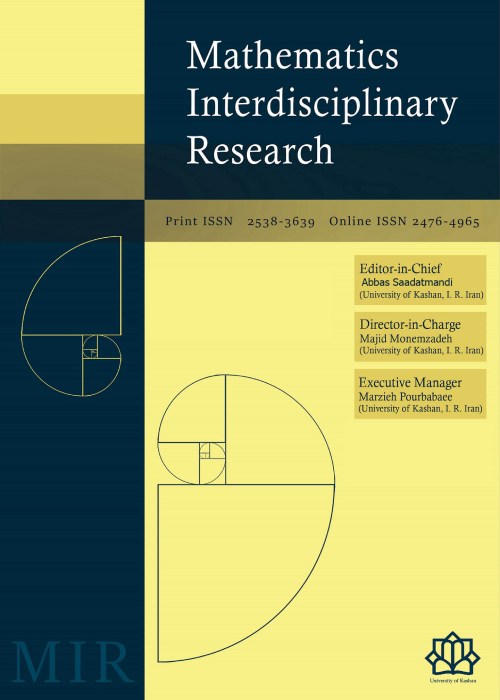فهرست مطالب

Mathematics Interdisciplinary Research
Volume:9 Issue: 1, Winter 2024
- تاریخ انتشار: 1402/12/11
- تعداد عناوین: 6
-
-
Pages 1-22We present an enhanced approach to solving the combined non-linear time-dependent Burgers-Fisher equation, which is widely used in mathematical biology and has a broad range of applications. Our proposed method employs a modified version of the finite element method, specifically the virtual element method, which is a robust numerical approach. We introduce a virtual process and an Euler-backward scheme for discretization in the spatial and time directions, respectively. Our numerical scheme achieves optimal error rates based on the degree of our virtual space, ensuring high accuracy. We evaluate the efficiency and flexibility of our approach by providing numerical results on both convex and non-convex polygonal meshes. Our findings indicate that the proposed method is a promising tool for solving non-linear time-dependent equations in mathematical biology.Keywords: Virtual element method, Burgers-Fisher equation, Convex mesh, Non-convex mesh, Non-linearity
-
Pages 23-43The representation theory of groups is one of the most interesting examples of the interaction between physics and pure mathematics, where group rings play the main role. The group ring $\rga$ is actually an associative ring that inherits the properties of the group $\ga$ and the ring of coefficients $R$. In addition to the fact that the theory of group rings is clearly the meeting point of group theory and ring theory, it also has applications in algebraic topology, homological algebra, algebraic K-theory and algebraic coding theory.In this article, we provide a complete description of Gorenstein flat-cotorsion modules over the group ring $\rga$,where $\ga$ is a group and $R$ is a commutative ring. It will be shown that if $\ga'\leqslant \ga$ is a finite-index subgroup, then the restriction of scalars along the ring homomorphism $\rga'\rt\rga$ as well as its right adjoint $\rga\otimes_{\rga'}-$, preserve the class of Gorenstein flat-cotorsion modules. Then, as a result, Serre's Theorem is proved for the invariant $\Ghcd_{R}\ga$, which refines the Gorenstein homological dimension of $\ga$ over $R$, $\Ghd_{R}\ga$, and is defined using flat-cotorsion modules. Moreover, we show that the inequality $\GF (\rga)\leqslant \GF (R)+{\cd_{R}\ga}$ holds for the group ring $\rga$, where $\GF (R)$ denotes the supremum of Gorenstein flat-cotorsion dimensions of all $R$-modules and $\cd_{R}\ga$ is the cohomological dimension of $\ga$ over $R$.Keywords: Group ring, Flat-cotorsion module, Gorenstein flat-cotorsion module, Gorenstein flat-cotorsion dimension
-
Pages 45-76Ricci bi-conformal vector fields have find their place in geometry as well as in physical applications. In this paper, we consider the Siklos spacetimes and we determine all the Ricci bi-conformal vector fields on these spaces.Keywords: Conformal vector fields, Siklos spacetimes, Riemannian metrics
-
Pages 77-88From the viewpoint of "extra dimension detecting," the phenomenon of the transition of the free point particle into 3d space is investigated. In this way, we formulate the problem using the second-class constrained system. To investigate it using a gauge theoretical approach, we use two methods to convert its two second-class constraints to first-class ones. In symplectic embedding, we construct a pair of scaler and vector gauge potentials, which can be interpreted as interactions for detecting extra dimensions. A Wess-Zumino variable appears as a new coordinate in potentials, and the particle's mass plays the role of a globally conserved charge related to the constructed gauge theory for extra dimensions.Keywords: Gauge, Extra dimension, Second-class, Symplectic embedding
-
Pages 89-109
In emergency situations, accurate demand forecasting for relief materials such as food, water, and medicine is crucial for effective disaster response. This research is presented a novel algorithm to demand forecasting for relief materials using extended Case-Based Reasoning (CBR) with the best-worst method (BWM) and Hidden Markov Models (HMMs). The proposed algorithm involves training an HMM on historical data to obtain a set of state sequences representing the temporal fluctuations in demand for different relief materials. When a new disaster occurs, the algorithm first determines the current state sequence using the available data and searches the case library for past disasters with similar state sequences. The effectiveness of the proposed algorithm is demonstrated through experiments on real-world disaster data of Iran. Based on the results, the forecasting error index for four relief materials is less than 10\%; therefore, the proposed CBR-BWM-HMM is a strong and robust algorithm.
Keywords: Demand forecasting, Emergency relief material, Case-based reasoning, Hidden Markov model -
Pages 111-129
The graph $ AG ( R ) $ {of} a commutative ring $R$ with identity has an edge linking two unique vertices when the product of the vertices equals {the} zero ideal and its vertices are the nonzero annihilating ideals of $R$.The annihilating-ideal graph with {respect to} an ideal $ ( I ) $, which is {denoted} by $ AG_I ( R ) $, has distinct vertices $ K $ and $ J $ that are adjacent if and only if $ KJ\subseteq I $. Its vertices are $ \{K\mid KJ\subseteq I\ \text{for some ideal}\ J \ \text{and}\ K$, $J \nsubseteq I, K\ \text{is a ideal of}\ R\} $. The study of the two graphs $ AG_I ( R ) $ and $ AG(R/I) $ and {extending certain} prior findings are two main objectives of this research. This studys {among other things, the} findings {of this study reveal}that $ AG_I ( R ) $ is bipartite if and only if $ AG_I ( R ) $ is triangle-free.
Keywords: Annihilating-ideal graph, Cut-point, Girth, $ r-$Partite graph

